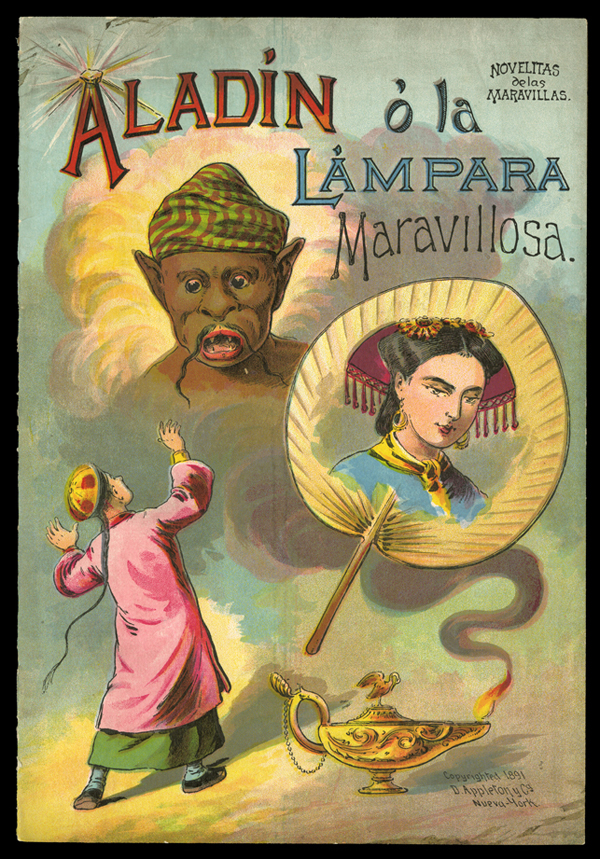

Aladín, ó, la Lámpara Maravillosa (1891) and Disney’s Aladdin (1992)

In the Spanish translation of “Aladdin and the Magic Lamp” published in 1891 by D. Appleton and Company, there is an illustration depicting the moment Aladdin meets the genie that was trapped inside of the lamp. In this version of the story, Aladdin uses the wishes granted by the genie in order to impress the daughter of the sultan after seeing her and falling in love at first sight. Although there are several similarities between this version of the fairy tale and Disney’s 1992 film version, the illustrations of each depict a stark contrast between the two stories, particularly regarding the comradery between Aladdin and the genie. Ultimately, the Disney illustrations suggest a movement towards more diversity in their films, but they actually prove that Disney believes a watered-down, Americanized representation of other cultures is preferred.
The focus of the illustration is the genie himself, who has a very large head, big pointy ears, a big nose, and an angry expression on his face. These features make this character seem very evil and intimidating compared to Aladdin. The genie’s mouth is open, revealing two sharp teeth. His fingers are almost claw-like because they are so long and pointy. Each of these details is characteristic of typically evil characters. The image of the genie is also very dark because of his complexion, the shadows on his face, and the clouds of smoke surrounding him. As the smoke cloud tapers towards the bottom of the illustration, it points to Aladdin, who very clearly just summoned the genie through the lamp he is holding in his right hand. Although Aladdin is wearing bright colors, the side of him that is facing the genie is very dark, suggesting the genie brings darkness to all of his surroundings with his presence. In contrast, Aladdin lacks wrinkles and jagged edges like the genie has, making him seem a lot more gentle and personable. The contrast of the darkness of the genie and his surrounding smoke to the background of the illustration, which is filled with pastel greens and pinks, suggests that the genie is a formidable character who may do harm to those around him. The genie’s size in comparison to Aladdin also demonstrates his power as a genie.
In contrast, Disney’s 1992 film Aladdin depicts a very different relationship between Aladdin and the genie. The background of the Disney illustration is very dark, while each character is lit up. The cave is drawn around the genie in order to frame the character and make sure the focus is on him. The genie has a glowing blue aura around him and he is comically using his genie tail as a microphone as he talks to Aladdin. He is still very large and seemingly powerful, but much less intimidating than the genie in the older illustration because of his bright color and large smile. The shackles on his wrists suggest some limitation to his power, which also makes him less intimidating. The clean lines that make up the genie character suggest that he is more tame and manageable than the genie of the first illustration. There is no smoke surrounding Disney’s genie and, rather than bringing darkness along with his presence, he emits light to all his surroundings. Aladdin, along with his two sidekicks, Abu and the magic carpet, are all standing in a line listening intently to what the genie has to say. None of the characters look fearful of the genie like Aladdin does in the 1891 illustration.
Through the dark colors and angry expression of the genie in the 1891 illustration, the illustrator depicts the genie as an evil character who reluctantly helps Aladdin out of obligation, while in Disney’s version, the genie is portrayed as a positive and friendly character who willingly aids Aladdin throughout the film. Aladdin relies heavily on the genie during the movie and often stands back as the genie takes the spotlight, acting out different comical impressions and pop-culture references. Disney also shed the genie of his dark skin and gave him a humorous role, complete with an American accent. So, in order for Disney to portray the genie as a friendly and likeable character, they had to Americanize both his appearance and his overall role. On the surface, a Disney film with a setting in the Middle East may seem more cultured than Disney’s typically white films, but this may not be the case. This film, along with others from the 1990’s, like Mulan (1998) and Pocahontas (1995), hint at Disney’s attempt to include more diverse protagonists, but ultimately fail to incorporate other cultures in a considerate and fair way.
To view Aladín, ó, la Lámpara Maravillosa , visit Special Collections in McCain Library 305. Ali Baba: or, the Forty Thieves can be found at de Grummond Stacks PZ8.A32 Ala8 1891. For more information about this book, contact Ellen Ruffin at or 601.266.6543, or view this item in its entirety at the University of Southern Mississippi Digital Collections.
Text by Kara Steidl, undergraduate student at Southern Miss. This Item of the Month stems from the Digital Archives Research Group’s Save Our Stories project, a project designed to introduce Southern Miss students to our archival holdings. To learn more about SOS or the Digital Archives Research Group at USM, visit the Digital Archives Research Group website. Congratulations to Kara Steidl on her strong work.